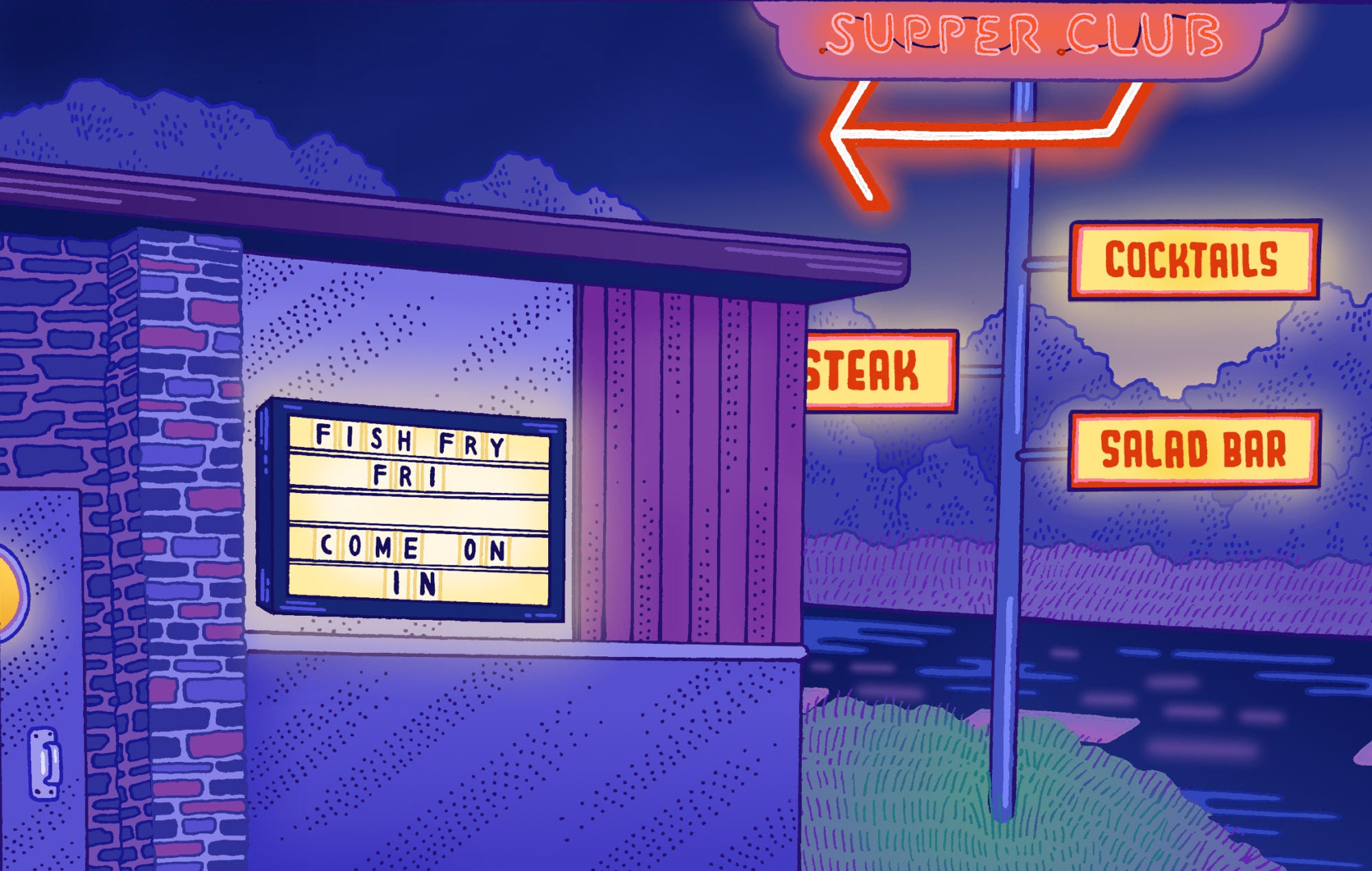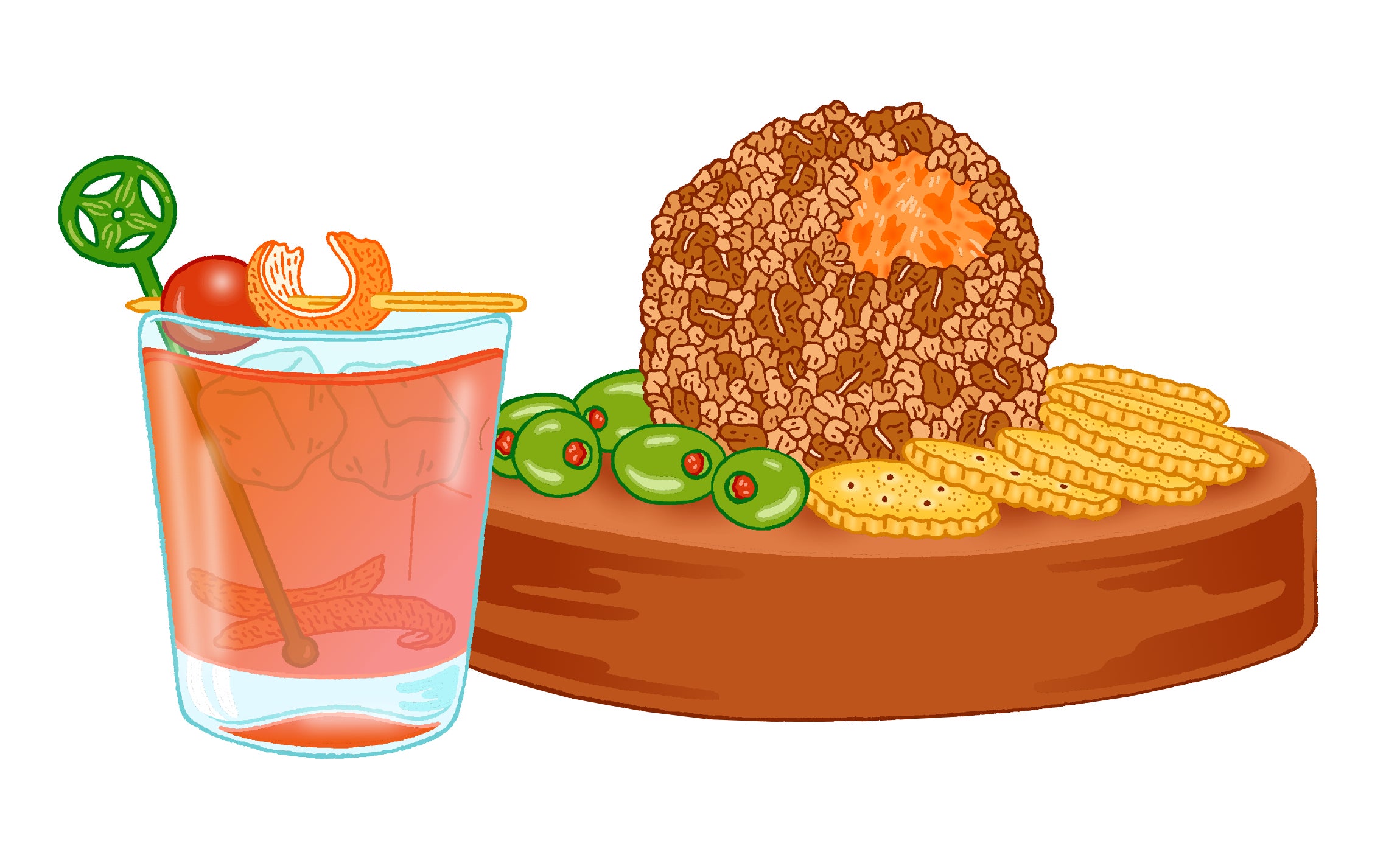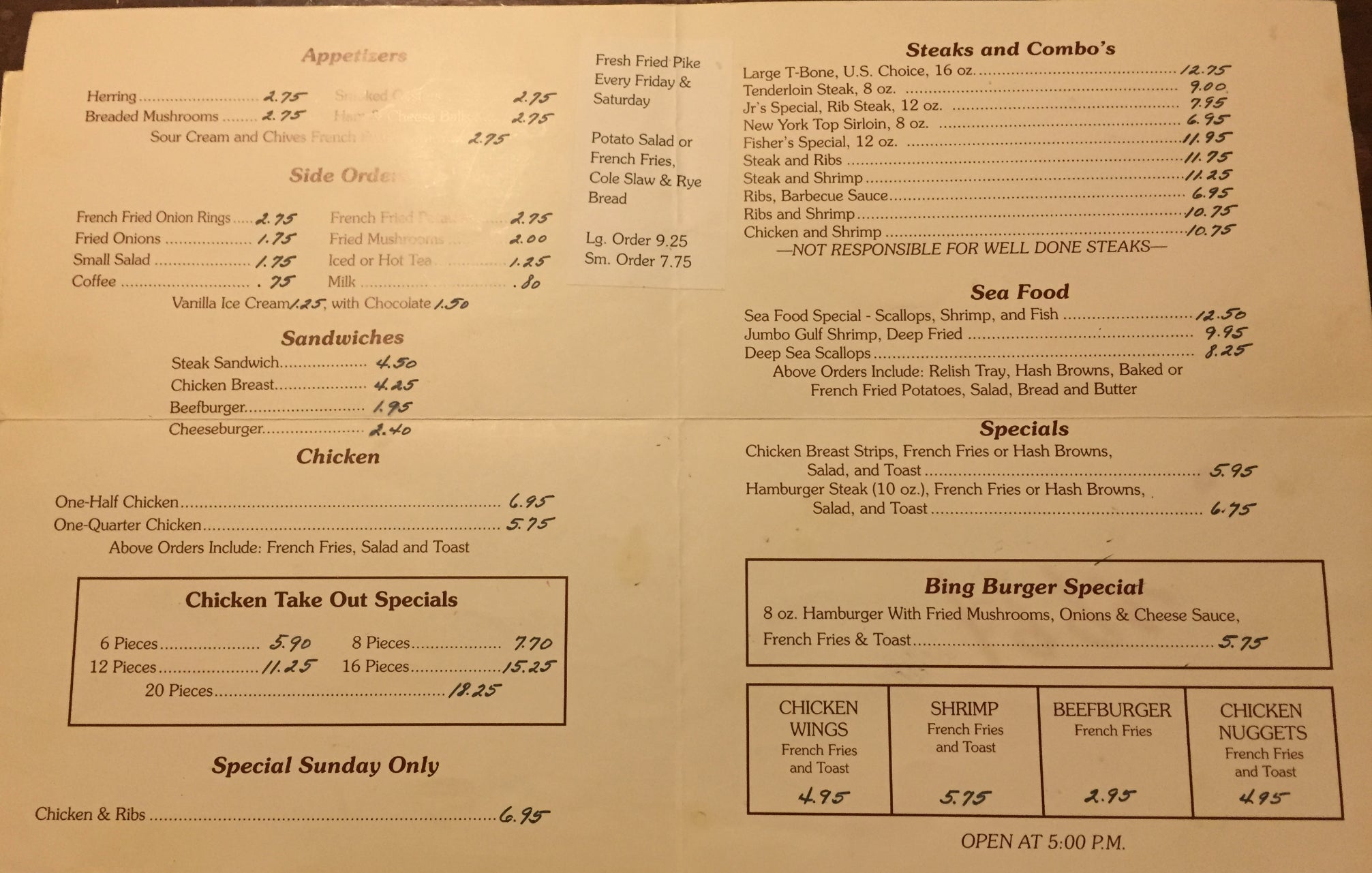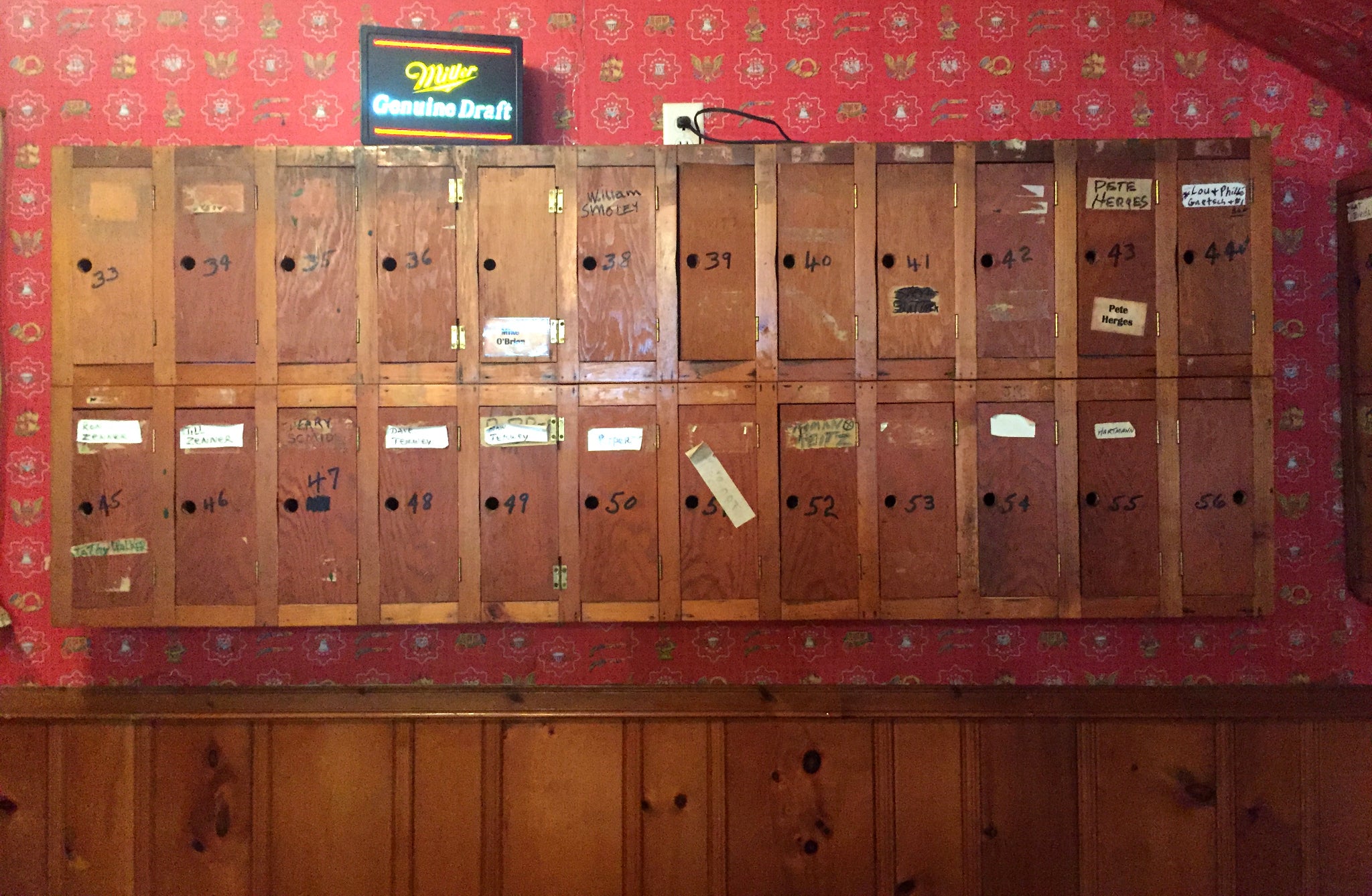
Supper clubs serving breaded fish and strong cocktails in rural Minnesota, Wisconsin, and Iowa are not your normal restaurant—but it’s also hard to say why until you visit one.
A classic Midwest supper club is hard to define. I grew up going to one. It was called—it still is called—the Great Blue Heron, in Cold Spring, Minnesota. It was a town of 2,000 people at the time, 80 miles north of Minneapolis. Put your finger in the middle of the state and that’s approximately where you’ll find it, surrounded by gently rolling hills covered in towering cornstalks (12 feet routinely), Holstein cows munching on wild grass, lakes filled with sunfish, and hundreds of miles of two-lane highway cutting through the vast, empty rest of it.
As you can imagine, dining options in Cold Spring were limited. When I was in fifth grade in the early ’90s, we got a Subway, and let me tell you, people went nuts. But through the decades, the Great Blue Heron sat reliably at the edge of town, off highway 23. With low-key Minnesotan humor, the movable letters on its roadside sign usually read “Come for the halibut.” This was, of course, a subtle and Catholic Church–OK’d reference to one of the two swear words adults ever used (my mother refused to say it outright, spelling out “h-e-double-hockey-sticks” instead). Inside, there was refinement. Patterned carpet, wrought-iron chandeliers, napkins folded like church steeples, stained glass windows, quiet, and a three-course dinner experience at the hour of supper, as it was called around there.
On special Friday or Saturday evenings, my grandma Rose took my cousins and me to eat at the Blue Heron. We wore slightly nicer than normal outfits—a freshly washed polo shirt, new tennis shoes—and sat at her usual round table near the entrance. Grandma ordered Rob Roys, and my cousins and I asked for Shirley Temples served in highballs on the rocks with straws, and then raced to the salad bar. We ladled French onion soup into cups and composed small iceberg lettuce salads with tomato slices, shredded cheddar cheese, sunflower seeds, and a side pickle. At the table we slurped our kiddie cocktails and tore off bites of marshmallow-white dinner rolls while we waited for the main course to arrive: walleye with a side of green beans, or a rib eye steak in a pool of boiling butter served on a silver tray. Or my favorite, chicken Kiev.
It wasn’t until I left Minnesota for college that I realized a supper club wasn’t just another name for restaurant, or that they didn’t exist outside of the upper Midwest. I knew Wisconsin was lousy with supper clubs (there are, supposedly, more than 400 of them in the state), and I would learn that they exist in Illinois and Iowa, too. But could I describe what a supper club was to an outsider? Not really. It was one of those things you knew when you saw it. So when I went home for a family reunion earlier this summer, I wanted to get to the bottom of it. Where did supper clubs come from? And what are they, really?

Technically, and oddly enough, the first supper club was in Beverly Hills, California, and established by a native of Milwaukee in the 1930s. But that date is key, because one event was essential to their growth: the end of Prohibition. Many of the most iconic supper clubs began in the ’30s and included large dance floors, live music, and banquet halls. They were places to celebrate socializing in public with newly legalized alcohol once again. This meant showing off your best date-night dress and suit, forking out more money than usual for a high-end meal, and, over the course of hours, taking down a stream of whiskey sours and gin and tonics. Going to the supper club wasn’t really about dinner; it was a social event.
Of course, a renewed enthusiasm for socializing in public with nice meals and a drink stuck to your hand does not account for the existence of supper clubs specifically, nor does it define exactly what they are. First, to state the obvious, a supper club is open only during the hours of supper—anytime after 4 p.m. Less obviously, there’s no membership, or membership fee, at supper clubs; you belong simply by showing up. Some of the first supper clubs were also “bottle clubs,” places where diners brought their own bottles of liquor and then stored them in miniature on-site lockers when they went home—but there was no extra charge for that, either.
And as explained in Minnesota Eats Out: An Illustrated History, Kathryn Strand and Linda Koutsky write that while urban nightclubs featured drinks and dancing with “classy” meals and cocktails, supper clubs were their “country cousins”—meaning they delivered a similar experience in a more casual package: large steaks, all-you-can-eat walleye, potato gratin, and post-dinner dancing to a local polka band playing “Beer Barrel Polka.” In the strictest sense of the term, supper clubs exist only where very little else does. A supper club is not just one destination in town; it’s literally the only place to go. And so everyone does.
And in Minnesota, a remote location often means that supper clubs are near lakes or lake resorts. My reunion was at a lake resort near Brainerd, Minnesota, so I went to check out the local supper club, Bar Harbor. Its original structure (which has since burned down) was built in 1938, and today it’s the destination for vacationers and locals in the Brainerd Lakes area.
I went early on a Sunday evening when the tourists had cleared out (they’d served 500 the night before) and the locals had arrived. One of them, Sandi McSweeney, sat at the center bar with four other women, all of whom lived across the street in the Bar Harbor Townhomes. Sandi didn’t grow up going to supper clubs, she said, because they were too expensive. If her family did go, it was a very special occasion—Easter or a birthday. Next to her sat Mary, from Austin, Minnesota, 100 miles south of Minneapolis. Mary and her husband had owned the supper club in Austin, the Old Mill. Austin is also home to Hormel, the meat packagers, which meant the Old Mill was a required stop for Hormel executives to wine and dine clients. “Hormel was our main customer,” Mary tells me, sipping a white wine. “We had clients from all over—China, and every place. It was very interesting.”
The Old Mill, like the Blue Heron, was formal: There was a row of windows facing the river (the structure had once been a flour mill), old pine paneling, and carpet that, says Mary, regularly caught wax from candles blown out at night. I loved Mary’s description of the hors d’oeuvres plate—or relish tray, as it’s often called—another staple of a classic supper club experience. It gave diners something to do before their cocktails arrived. Mary’s version was served high on a platter—so everyone at the table could reach it—with a cheddar cheese ball, chicken wings, pickled herring, and olives. In the kitchen, the chef prepared barbecue ribs and cut his own fillets and New York strips using beef from Hormel, then ground his own hamburgers from scrap. Every meal ended with a free brownie. Long Hormel company dinners took place in two private dining rooms, where cocktails arrived strong, simple, and brown—old-fashioneds, Manhattans, or just whiskey with water and juice.
I ask what Mary missed most about running the Old Mill. “I miss the fun,” she says. “The salesmen from Hormel who came every week to our place—it was just like a family.”
And this gets to the finer point of what defines a Midwest supper club. That is, the fun you have once you’re inside because of everyone else who shows up with you, or who you run into once you’re there. In The Supper Club Book: A Celebration of Midwest Tradition, Dave Hoekstra writes, “The supper club is about the longing for belonging. No one goes to a supper club alone.” One of Minnesota’s most iconic supper clubs, Fisher’s Club (the voice of Minnesota, Garrison Keillor, was once an owner), in Avon, Minnesota, does not provide the traditional supper club fanciness, but its ability to draw a teeming crowd of hungry Minnesotans from a constellation of small towns, both near and not-so-near, is known throughout the state. Sometimes my parents skipped out on the Blue Heron and drove 20 minutes up County Highway 50 to meet their friends for Fisher’s all-you-can-eat breaded walleye fish fry, a recipe that Fisher’s still keeps secret.
George Fisher, a retired baseball player at 33, opened Fisher’s Club in 1932 on the shore of Middle Spunk Lake. At first it was just a tiny wooden structure with a bar, and today it is only slightly less tiny, with a main dining room and front porch added, but its aesthetic is equally unfussy: There’s a jukebox with Hank Williams, pine wall paneling, and—highly unusual—no carpet. Today, Fisher’s has a full liquor license and beer on tap, but for decades it was one of Minnesota’s longest- and last-standing bottle clubs. Regulars purchased their favorite spirits and stored them in mini lockers made of Douglas fir located behind the bar; their names were written on strips of tape attached to the locker door. They would arrive at 5 p.m., sip their Canadian Club Whiskey or corn-based moonshine, catch up with neighbors, and get slightly plowed while waiting for their walleye and potato salad to show up.
Things don’t go down much differently today, though all of the original Fisher family owners have passed away, and bottle clubs are now illegal in Minnesota. Two cousins who grew up working and eating at Fisher’s, Jacob and Cory Voss, run it now. I meet Jacob at Fisher’s on a Monday morning, when it’s closed and I’m heading back out of town. He wears a baseball cap that reads “Fisher’s Club” and explains that when he was growing up, he ate at Fisher’s probably once a month with a large group of his extended family. “I mean, not too large,” he adds. “No more than 20.”
It’s dead quiet in the cool lakeside building at 10:30 a.m., but I can feel the ghosts of extended, booze-fueled Friday nights all around us, loud conversation bleeding table to table, and imagine the smoky aroma of freshly fried fish. What was it like, I wonder, when he showed up with his family for a meal at Fisher’s? “We would come in and just be ready to enjoy our time,” says Jacob, who’s already told me that as a teenager, working there didn’t really feel like work. “There was no rush. You were just here, in the present.”
I want to return to the place that had introduced me to the supper club, see if anything had changed. I meet Nick Stang, the owner of the Blue Heron, who’d started working there as a dishwasher when he was 14. Standing near the hostess stand, Nick explains he’ll never compromise on the quality of the food he serves, nor get rid of the spirit of the supper club experience, nor, God forbid, do away with the salad bar (“It really is a staple, and I would be lynched if I got rid of it”), but the next generation wants what it wants. Going out to eat, period, has become commonplace. Nearly everywhere—including central Minnesota—there is an abundance of choice. Now the supper club is just one of them.
“We’re going to keep it the familiar place older generations knew and cater a little bit to the newer generations,” says Nick. “I’ve started to talk about it with different customers. Eventually I’m going to make this front area here more like the bar area, with TVs. They’ll still have the formal room as an option, but there won’t be as big of an area for it. Because my bar is always full—and sometimes the dining room is too, and the bar is not, but”—well, you can’t ignore the facts.
I wonder if my grandma’s preferred round table is still in its same place. I find it in the main dining room, smaller than I remembered, stuck in a corner. There is no view to the manicured lawn outside, just a stained glass window depicting a blue heron, looking directly into the salad bar. I’m confused. Why did my grandma like this table?
“I think, for your grandma—because it was near the front—everyone she knew walked by. And so she could say hi, you know? I think that was one of her favorite parts of being here. That was comfortable to her, to casually say hi or have a conversation.”
My grandma didn’t need the view. She needed the people in the Blue Heron, which meant she needed the town, and it was just a little more fun to see them all with a Rob Roy in her hand. But I needed the owner of the local supper club to point that out.


